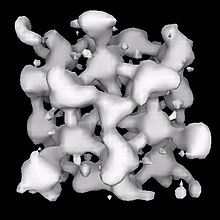Electride

An electride is an ionic compound in which an electron is the anion.[1] Solutions of alkali metals in ammonia are electride salts.[2] In the case of sodium, these blue solutions consist of [Na(NH3)6]+ and solvated electrons:
- Na + 6 NH3 → [Na(NH3)6]+,e−
The cation [Na(NH3)6]+ is an octahedral coordination complex.
Solid salts
Addition of a complexant like crown ether or 2,2,2-cryptand to a solution of [Na(NH3)6]+e− affords [Na (crown ether)]+e− or [Na(2,2,2-crypt)]+e−. Evaporation of these solutions yields a blue-black paramagnetic salt with the formula [Na(2,2,2-crypt)]+e−.
Most solid electride salts decompose above 240 K, although [Ca24Al28O64]4+(e−)4 is stable at room temperature.[3] In these salts, the electron is delocalized between the cations. Electrides are paramagnetic and Mott insulators. Properties of these salts have been analyzed.[4]
Reactions
Solutions of electride salts are powerful reducing agents, as demonstrated by their use in the Birch reduction. Evaporation of these blue solutions affords a mirror of Na. Such solutions slowly lose their colour as the electrons reduce ammonia:
- 2[Na(NH3)6]+e− → 2NaNH2 + 10NH3 + H2
This conversion is catalyzed by various metals.[5] An electride, [Na(NH3)6]+e−, is formed as a reaction intermediate.
High-pressure elements
Theoretical evidence supports electride behaviour in insulating high-pressure forms of potassium, sodium, and lithium. Here the isolated electron is stabilized by efficient packing, which reduces enthalpy under external pressure. The electride is identified by a maximum in the electron localization function, which distinguishes the electride from pressure-induced metallization. Electride phases are typically semiconducting or have very low conductivity,[6][7][8] usually with a complex optical response.[9] A sodium compound called disodium helide has been created under 113 gigapascals of pressure.[10]
See also
References
- ^ Dye, J. L. (2003). "Electrons as Anions". Science. 301 (5633): 607–608. doi:10.1126/science.1088103. PMID 12893933.
- ^ Holleman, A. F.; Wiberg, E. "Inorganic Chemistry" Academic Press: San Diego, 2001. ISBN 0-12-352651-5
- ^ Buchammagari, H.; et al. (2007). "Room Temperature-Stable Electride as a Synthetic Organic Reagent: Application to Pinacol Coupling Reaction in Aqueous Media". Org. Lett. 9 (21): 4287–4289. doi:10.1021/ol701885p. PMID 17854199.
- ^ Wagner, M. J.; Huang, R. H.; Eglin, J. L.; Dye, J. L. Nature, 1994,368, 726-729.
- ^ Greenlee, K. W.; Henne, A. L. (1946). Sodium Amide. Inorganic Syntheses. Vol. 2. pp. 128–135. doi:10.1002/9780470132333.ch38. ISBN 9780470132333.
- ^ Marques M.; et al. (2009). "Potassium under Pressure: A Pseudobinary Ionic Compound". Physical Review Letters. 103 (11): 115501. Bibcode:2009PhRvL.103k5501M. doi:10.1103/PhysRevLett.103.115501. PMID 19792381.
- ^ Gatti M.; et al. (2010). "Sodium: A Charge-Transfer Insulator at High Pressures". Physical Review Letters. 104 (11): 216404. arXiv:1003.0540. Bibcode:2010PhRvL.104u6404G. doi:10.1103/PhysRevLett.104.216404. PMID 20867123.
- ^ Marques M.; et al. (2011). "Crystal Structures of Dense Lithium: A Metal-Semiconductor-Metal Transition" (PDF). Physical Review Letters. 106 (9): 095502. Bibcode:2011PhRvL.106i5502M. doi:10.1103/PhysRevLett.106.095502. PMID 21405633.
- ^ Yu, Zheng; Geng, Hua Y.; Sun, Y.; Chen, Y. (2018). "Optical properties of dense lithium in electride phases by first-principles calculations". Scientific Reports. 8 (1): 3868. arXiv:1803.05234. Bibcode:2018NatSR...8.3868Y. doi:10.1038/s41598-018-22168-1. PMC 5832767. PMID 29497122.
- ^ Wang, Hui-Tian; Boldyrev, Alexander I.; Popov, Ivan A.; Konôpková, Zuzana; Prakapenka, Vitali B.; Zhou, Xiang-Feng; Dronskowski, Richard; Deringer, Volker L.; Gatti, Carlo (May 2017). "A stable compound of helium and sodium at high pressure". Nature Chemistry. 9 (5): 440–445. arXiv:1309.3827. Bibcode:2017NatCh...9..440D. doi:10.1038/nchem.2716. ISSN 1755-4349. PMID 28430195.
Further reading
- J. L. Dye; M. J. Wagner; G. Overney; R. H. Huang; T. F. Nagy; D. Tománek (1996). "Cavities and Channels in Electrides" (reprint). J. Am. Chem. Soc. 118 (31): 7329–7336. doi:10.1021/ja960548z.
- JCTC
